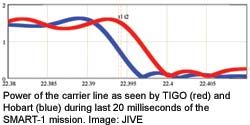News / Press Releases
Radio astronomers record final moments of SMART-1 spacecraft
Printer-friendly version
 DWINGELOO,
The Netherlands (4 September 2006) --
The European Space Agency's SMART-1 spacecraft
completed its almost three year mission early Sunday
with a controlled impact with the surface of the Moon.
A network of radio telescopes, led by European radio
astronomers from the Joint Institute for VLBI in
Europe (JIVE, Dwingeloo, the Netherlands) observed
SMART-1 and recorded key data during its final
moments and impact.
DWINGELOO,
The Netherlands (4 September 2006) --
The European Space Agency's SMART-1 spacecraft
completed its almost three year mission early Sunday
with a controlled impact with the surface of the Moon.
A network of radio telescopes, led by European radio
astronomers from the Joint Institute for VLBI in
Europe (JIVE, Dwingeloo, the Netherlands) observed
SMART-1 and recorded key data during its final
moments and impact.
The impact occurred at about 05:42 UT (07:42 CEST) Sunday 3 September 2006, when the Moon was below the horizon in Europe. European telescopes were unfavorably located to observe the impact, but the Medicina 32-m Radio Telescope (Istituto di Radioastronomia, INAF, Bologna, Italy) paid tribute to the mission by recording the last final transmission of SMART-1 over Europe about 11 hours before impact. Later, monitoring continued as European radio astronomers received and recorded radio transmissions from the spacecraft using the ROEN (Northeastern Space Radio Observatory, Fortaleza, Brazil), Transportable Integrated Geodetic Observatory (TIGO, Concepcion, Chile), Mt. Pleasant Observatory (Hobart, Australia) and the CSIRO Australia Telescope Compact Array (Narrabri, NSW, Australia). All five telescopes operated in Very Long Baseline Interferometry (VLBI) mode. The data from VLBI monitoring of SMART-1 is being processed at JIVE.
VLBI permits signals received at multiple radio telescopes to be used together to produce images of celestial radio sources with extremely high resolution. Data from all five radio telescopes observing SMART-1 during the last hours of the mission will be processed at JIVE using software first developed and used for tracking of ESA's Huygens Probe during its descent through Titan's atmosphere in January 2005. The strength of the signal received by all five telescopes combined with SMART-1's close proximity, only meters from the surface before impact, will enable analysis of very fine physical phenomena of the Moon.
The SMART-1 mission was conceived by ESA as a pathfinder of new technologies, particularly in the area of propulsion and "science reconnaissance." The VLBI experiment, as the latest addition to the SMART-1 science programme, perfectly complements the mission's purpose of innovation. It paves the way for future applications of the VLBI technique for prospective planetary probes. These applications will include experiments that require extremely accurate time and position measurements. They will also allow radio astronomers to detect very weak radio phenomena associated with the physical properties of planets and other celestial bodies. These experiments will address such diverse areas of science as comparative planetology and fundamental physics.
Additionally, a portion of data from the TIGO telescope in Chile and the Mt. Pleasant Observatory in Australia was sent to JIVE as part of the EXPReS project (Express Real-time e-VLBI Service) coordinated by JIVE and funded by the European Commission (DG-INFSO). e-VLBI is a type of VLBI which uses optical networks to connect the telescopes in real-time, creating a distributed radio telescope of continental and intercontinental dimensions. This data transfer was made possible by close collaboration of the REUNA (Chile), RedCLARA (South America), GÉANT2 (Europe) and SURFnet (Netherlands) networks.
Using e-VLBI techniques, astronomers at JIVE received an important 10 seconds of data concerning the precise time and velocity at impact from Chile and Australia in a matter of seconds, and additional data were transferred and processed in a matter of hours. With this data astronomers were able to determine the time of impact within 10 microseconds (10 millionths of a second), equating to two centimeters along the spacecraft's trajectory.
This and earlier observations of SMART-1 validate the use of e-VLBI and ground observations for tracking future lunar and planetary missions such as China's Chang'E-1 Lunar orbiter, scheduled for launch in 2007.
About JIVE
The Joint Institute for VLBI in Europe (JIVE,
www.jive.nl) was
established as a scientific foundation in December 1993.
JIVE’s mandate is to support the operations of the European
VLBI Network (EVN) in the widest sense. The major activity
has been the development, construction and successful
operation of the EVN Data Processor, a powerful supercomputer
that combines the signals from radio telescopes located
across the planet, creating one huge telescope of
intercontinental dimensions. Using this technique of Very
Long Baseline Interferometry (VLBI), astronomers can
make detailed images of cosmic radio sources, providing
astronomers with the clearest, highest resolution view of
some of the most distant and energetic objects in the Universe.
About EXPReS
Express Production Real-time e-VLBI Service
(EXPReS, www.expres-eu.org),
is a three-year project funded by the European Commission with
the objective of creating a distributed, large-scale astronomical
instrument of continental and intercontinental dimensions.
This electronic Very Long Baseline Interferometer (e-VLBI)
is achieved using high-speed communication networks operating
in real-time and connecting together some of the largest and
most sensitive radio telescopes on the planet. EXPReS is
coordinated by JIVE, the Joint Institute for VLBI in Europe
(www.jive.nl), which is hosted by
ASTRON, the Netherlands Foundation for Research in Astronomy
(www.astron.nl), in Dwingeloo.
# # #
Contact:
Dr Leonid Gurvits
Joint Institute for VLBI in Europe (JIVE)
+31 521-586514 (office)
+31 529-015149 (mobile)
lgurvits@jive.nl
Kristine Yun, Public Outreach Officer
Express Production Real-time e-VLBI Service (EXPReS)
Joint Institute for VLBI in Europe
+31 521-596543
kyun@jive.nl
www.expres-eu.org
Links:
- Additional impact timing images
- EXPReS logo (small, 150x78 JPG, 6K)
- EXPReS logo (medium, 400x208 JPG, 20K)
- JIVE logos (JIVE Web site)
- SMART-1 images (ESA Web site)
Credits: